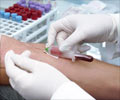Results of a long-awaited study of 3,070 American adults at Johns Hopkins and 118 other U.S. medical centers show that treatment with either of the two standard antiviral drug therapies
Results of a long-awaited study of 3,070 American adults at Johns Hopkins and 118 other U.S. medical centers show that treatment with either of the two standard antiviral drug therapies is safe and offers the best way for people infected with hepatitis C to prevent liver scarring, organ failure and death.
A report on the so-called comparative effectiveness study, believed to be the largest of its kind conducted on people with hepatitis C infections, appears in the New England Journal of Medicine online July 22. The disease, transmitted by contact with blood and other body fluids of an infected person, through sexual activities, injection drug use or sharing of personal care items, kills more than 10,000 Americans annually. An estimated 180 million people worldwide, including 4 million in the United States, are infected with hepatitis C, the nation's leading cause of liver failure, liver cancer and liver transplantation."When considering treatments for hepatitis C infection, patients and their doctors now have solid evidence that they can weigh both antiviral therapies equally for effectiveness, safety and tolerability," says study co-principal investigator Mark Sulkowski, M.D., medical director of Johns Hopkins' Center for Viral Hepatitis.In a surprise finding, the researchers say, the study found no major difference between the only two U.S. Food and Drug Administration-approved drug treatment regimens in suppressing the virus to undetectable levels in the blood.
Either of the two standard, 48-week, dual drug therapies – peginterferon alfa-2b, plus ribavirin, or peginterferon alfa-2a, plus ribavirin – worked equally well, at 39.8 percent and 40.9 percent, respectively. Side effects, such as anemia, fatigue, headache, nausea, insomnia and depression, were commonly observed in study participants. Between 10 percent and 13 percent of study participants withdrew from treatment due to their drug side effects, a number Sulkowski says is "within expectations for this type of therapy." However, the new study, he says, shows that "we now have evidence that we can safely use less aggressive dosages without compromising a patient's chances for long-term recovery."
In a subgroup of 700 patients who took a lower dose of peginterferon alfa-2b (a change from the standard 1.5 micrograms per kilogram per week to 1 microgram per kilogram per week peginterfon alfa-2b) did just as well, with a cure rate of 38 percent.
Sulkowski, an associate professor at the Johns Hopkins University School of Medicine, says the team's latest research also shows that delaying treatment until the disease has reached an advance stage hurts prognosis.
"Treatment success is highly dependent on starting before liver cirrhosis has already set in, which can take from a year to decades," says Sulkowski.
Advertisement
Put another way, twice as many infected people recovered on either set of injected drugs as long as the treatment was begun before the disease had led to pronounced liver disease.
Advertisement
Researchers found that a patient's likelihood of success after taking either antiviral medication was highly predictable, even within 30 days, based on the magnitude of viral decline. Approximately 90 percent of patients were cured if virus levels in the blood were suppressed within a month to below detection, whereas patients who took from three months to six months to achieve viral suppression had higher rates of viral rebound (of between 30 percent and 50 percent.)
In a piece of reassuring news, the study appeared to allay fears about switching to less aggressive drug treatments in response to severe side effects with anemia, showing it can be safe and effective to reduce the does of the antiviral drug ribavirin to doses below those initially prescribed.
Moving forward, researchers say the higher rates of viral eradication in infected people in the early stages of liver disease warrants more widespread screening in people at greater risk of being infected, such as those with liver inflammation, anyone who received a blood transfusion before donor testing for hepatitis C began in 1992, and injection-drug users.
Researchers also found that in the third of study participants whose ribavirin dosage was reduced as a result of anemia, cure rates actually improved to as high as 52 percent, whereas in those whose ribavirin dose stayed the same, cure rates were lower, at 37 percent.
"Contrary to the prevailing belief that ribavirin dose reduction would lead to fewer people recovering from their infection, it actually increased the sustained viral response rate when reduction was used to manage treatment-related anemia," says Sulkowski, who attributes the onset of anemia as a sign that the body had sufficient ribavirin to fight off the infection.
"Our study shows that in infected people having difficulty tolerating standard dose therapy with peginterferon alfa, we can safely reduce their medication levels," he says.
The study also confirmed that blacks infected with hepatitis C, who comprised almost a fifth of all study participants, fare more poorly over the course of their disease, even with early therapy. They experienced roughly half the viral suppression rates of whites for every tested regimen. Sulkowski says the reasons for this remain unknown and subject to further research.
"As the largest study of its kind, our trial, called IDEAL, defines the current standard of care for treating hepatitis C infection," says study co-investigator David L. Thomas, M.D., director of infectious diseases at Johns Hopkins. "The study findings tell doctors how to treat hepatitis C infection today and underscore the importance of new therapies for the majority of people who cannot currently be cured." Thomas was one of four hepatitis C experts responsible for drafting the 2009 guidelines for the diagnosis, management and treatment of hepatitis C, recently published by the American Association for the Study of Liver Diseases, a national, professional society.
Sulkowski notes that comparative-effectiveness studies such as this one, despite their high cost and lengthy timelines, form the "fundamental backbone" for figuring out which one works best with newer treatments in the pipeline. Proposed next-stage therapies, primarily two hepatitis protease-inhibitors, boceprevir and teleprevir, are still in early testing, but can now be judged in comparison with what physicians know works best. Sulkowski says triple-combination drug therapies for hepatitis C could prove the current therapies more effective when used as a cocktail, similar to the antiviral regimens used to combat HIV.
In the latest study, recently infected people from across the United States were randomly assigned to one of three treatment groups, receiving either standard-dose peginterferon alfa-2b or peginterferon alfa-2a, each with ribavirin, or low-dose peginterferon alfa-2b, plus ribavirin. A majority of study participants were men in their 40s. All were treated for nearly a year and then monitored for another half-year. None had pre-existing conditions, such as HIV disease, another hepatitis infection, liver failure or liver cancer, or severe or active depression.
Researchers say the next phase of their research will profile people who do better on each different drug regimen to see if there are standout factors that predispose some to success on one drug over another.
They also plan further studies on drug-induced anemia to determine the effectiveness of synthetic erythropoietin, and whether or not EPO is more effective in some people than in others.
Source-Eurekalert
SRM















